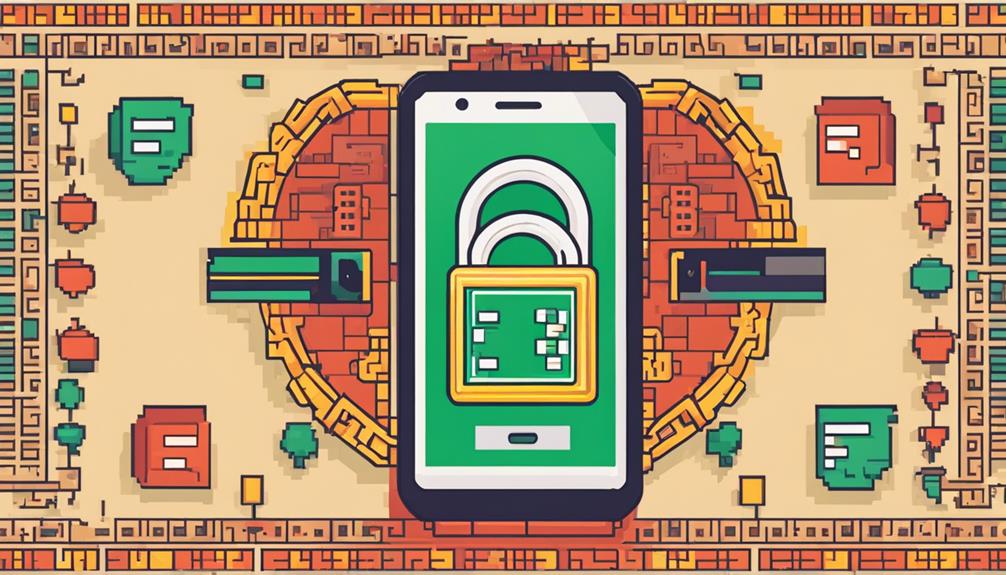Google Pay is secure from hackers due to robust security measures. Two-factor authentication and encryption protect user data, while tokenization secures transactions. Constant monitoring by fraud prevention teams and remote phone locking enhance security. The platform adheres to industry standards like PCI, undergoes regular security audits, and safeguards against hackers. Encryption shields payment information, fraud monitoring detects unusual activities, and limited data storage reduces breach risks. The system intervenes promptly during security breaches. The thorough security measures guarantee a secure environment for transactions on Google Pay. Further insights await regarding its protective features.
Key Takeaways
- Encryption safeguards payment info from hackers.
- Fraud monitoring detects and prevents fraudulent activities.
- Limited data storage reduces risk of data breaches.
- Continuous transaction monitoring for suspicious behavior.
- Immediate intervention in case of security breaches.
Security Measures in Google Pay
Numerous security measures are implemented in Google Pay to guarantee the protection of user data and transactions. One of the key security features is two-factor authentication, which adds an extra layer of protection by requiring users to verify their identity using a second method, such as a code sent to their phone. This feature greatly reduces the risk of unauthorized access to accounts even if passwords are compromised.
In addition to two-factor authentication, Google Pay encrypts user data and uses tokenization for secure transactions. These methods ensure that sensitive information is protected from prying eyes and hackers.
Moreover, fraud prevention teams continuously monitor for any suspicious activity and provide the option to remotely lock a user's phone in case it is lost or stolen. By following PCI security requirements, undergoing regular security audits, and strictly adhering to data protection standards, Google Pay maintains a robust security infrastructure to safeguard user information effectively.
2-Factor Authentication for Transactions

Google Pay enhances transaction security by implementing two-factor authentication for transaction confirmation. This additional layer of security requires users to verify their identity through a secondary method, such as a unique code sent to their phone.
2-factor authentication plays an important role in preventing unauthorized access to Google Pay accounts and improving overall transaction security. Even if a hacker manages to obtain a user's login credentials, they would still need the second verification, adding a substantial barrier against fraudulent transactions and unauthorized account access.
Data Encryption and Tokenization

Google Pay employs robust data encryption to shield user information during transactions, ensuring a high level of security.
Additionally, tokenization technology adds another layer of protection by preventing the transmission of actual card numbers.
These security measures, encryption, and tokenization work in tandem to safeguard sensitive payment data from potential threats, making Google Pay a secure option for digital transactions.
Encryption Strengths
Data encryption and tokenization are essential security features in Google Pay to protect user information during transactions.
Google Pay employs robust encryption methods to safeguard sensitive data like credit card numbers from unauthorized access. The encryption protocols ensure that this information is securely encrypted while in transit between devices.
Furthermore, tokenization plays a key role in enhancing security by replacing actual card details with unique tokens. This substitution adds an additional layer of protection, mitigating the risk of potential breaches.
Tokenization Benefits
Tokenization offers a significant advantage in enhancing the security of user data by replacing sensitive information with unique tokens during transactions. In the case of Google Pay, this means that actual card details are not transmitted, reducing the risk of data breaches.
The tokens generated for each transaction are random and cannot be reverse-engineered to obtain the original card information, adding an extra layer of security. Data encryption and tokenization complement each other in Google Pay, working together to safeguard payment information.
Security Measures Implemented
Implemented to bolster the security of payment information, data encryption and tokenization are integral components of Google Pay's robust security measures.
Data encryption scrambles sensitive information, rendering it unreadable to unauthorized parties. This encryption guarantees that even if hackers intercept the data, they cannot decipher it.
Additionally, tokenization replaces actual card details with unique tokens, reducing the risk of data theft. By using tokens instead of real card numbers, Google Pay enhances the security of transactions, making it difficult for hackers to misuse payment information.
These sophisticated security measures create multiple layers of protection, safeguarding users' financial data from cyber threats.
With data encryption and tokenization working in tandem, Google Pay provides a secure platform for conducting transactions online, giving users peace of mind regarding the safety of their sensitive information.
Monitoring for Suspicious Activity

Google Pay's robust fraud prevention teams work around the clock to monitor for any suspicious activity. They employ a combination of manual oversight and automated processes to swiftly detect and prevent fraudulent transactions.
Additionally, users benefit from features like activity alert notifications and the ability to track their payment history for added security and peace of mind.
Activity Alert Notifications
Enhancing user security, the activity alert notifications provided by Google Pay serve as an essential tool in monitoring for suspicious transactions. Users benefit from real-time alerts that notify them of any unusual activities on their accounts. These alerts play a vital role in enabling users to promptly identify and report any unauthorized transactions, thereby enhancing the overall security of Google Pay.
Monitoring for suspicious activity is a fundamental aspect of Google Pay's security measures, with these notifications acting as a frontline defense against potential hacking attempts. By receiving immediate alerts for any suspicious transactions, users can take swift action to protect their accounts and finances.
Google Pay's proactive approach to alerting users to potential security threats demonstrates its commitment to safeguarding user information and maintaining a secure platform for digital transactions.
Tracking Payment History
Monitoring payment history in Google Pay provides users with valuable insights into their transaction activities, enabling them to detect and address any suspicious or unauthorized charges effectively. By reviewing transaction details such as merchant names, dates, and amounts, users can verify the legitimacy of all payments.
This feature is vital as it helps users identify any unusual or unfamiliar charges that may indicate potential fraudulent activity. Google Pay's transparency in providing visibility into all transactions adds an extra layer of security and peace of mind for users.
Regularly checking payment history is essential as it allows users to promptly identify and report any unauthorized access to their Google Pay account. This proactive approach to monitoring payment history not only safeguards users from falling victim to fraudulent transactions but also empowers them to take swift action in case of any suspicious activities on their account.
Compliance With PCI Requirements

Ensuring compliance with Payment Card Industry (PCI) requirements is essential for maintaining a secure payment environment within Google Pay. Google Pay adheres to PCI security requirements to protect users' payment information.
Here's how compliance with PCI standards benefits users:
- Security Standards: PCI requirements establish industry standards for handling sensitive payment data securely, reducing the risk of data breaches.
- Fraud Prevention: By following PCI standards, Google Pay demonstrates its commitment to data security and fraud prevention, instilling trust among users.
- User Protection: Compliance with PCI standards helps Google Pay uphold a safe platform for transactions, ensuring that users' payment details are safeguarded from potential threats.
Regular Security Audits

To maintain the integrity of its secure payment environment, Google Pay rigorously conducts regular security audits to assess system safety and compliance with industry standards. These security audits play a pivotal role in identifying vulnerabilities and evaluating the effectiveness of existing security protocols.
By performing these audits regularly, Google Pay can proactively detect and address potential security threats and weaknesses that may compromise the platform's security.
Through these audits, Google Pay guarantees that robust security measures are in place to safeguard user data and maintain the overall security of its payment platform. The frequency of these security audits underscores Google Pay's dedication to providing a secure environment for its users.
Safeguards Against Hackers

How does Google Pay fortify its defenses to protect against potential hacker threats?
Google Pay employs a range of safeguards to guarantee user security when using the platform. Here are three key measures in place:
- Encryption:
Google Pay utilizes robust encryption protocols to safeguard payment information, making it challenging for hackers to intercept or decipher sensitive data.
- Fraud Monitoring:
Transactions on Google Pay undergo constant monitoring for any signs of fraudulent activities or suspicious behavior, allowing for prompt intervention in case of any security breaches.
- Limited Data Storage:
Google Pay does not retain users' credit or debit card details, reducing the risk of data breaches. By minimizing stored data, the platform reduces the potential impact of any hacking attempts.
Frequently Asked Questions
Is Google Pay Safe From Hackers?
Google Pay provides a secure platform for transactions by employing encryption, fraud monitoring, and multi-layer security features. With the absence of stored card details and the option to lock accounts, Google Pay offers robust protection against hacking attempts.
Is Google Pay Safe From Skimmers?
Google Pay offers robust protection against skimmers by employing virtual card numbers, encryption, and temporary unique tokens. Skimmers are unable to access sensitive information during transactions, enhancing the overall security of using Google Pay.
What Are the Downsides of Google Pay?
Google Pay users should be aware of potential downsides, including susceptibility to phishing attacks, risks from fraudulent apps, vulnerabilities on unsecured networks, account takeover through social engineering, and the need for vigilant transaction monitoring.
Is It Safe to Add a Credit Card to Google Pay?
Adding a credit card to Google Pay is generally considered safe due to its robust security measures such as tokenization, encryption, secure servers, and two-factor authentication. Financial professionals endorse its safety for transactions.
Conclusion
To sum up, Google Pay employs various security measures to protect users from hackers. With 2-factor authentication, data encryption, and monitoring for suspicious activity, the platform prioritizes customer safety.
Compliance with PCI requirements and regular security audits further enhance the security of transactions. An interesting statistic to note is that in 2020, Google Pay reported a 99.99% success rate in preventing fraudulent transactions, highlighting the effectiveness of their security measures.









